Il ricamo a macchina su tessuto chiffon può aggiungere un tocco delicato ed elegante a qualsiasi progetto, ma arriva con le sue sfide. The fabric’;La sua natura leggera e pura rende difficile lavorarci, richiedono strumenti e tecniche adeguati per evitare increspature e distorsioni.
In questa guida, ti mostreremo come ricamare con successo sullo chiffon coprendo tutto, dalla preparazione ai ritocchi finali, assicurando che i tuoi disegni vengano fuori magnificamente.
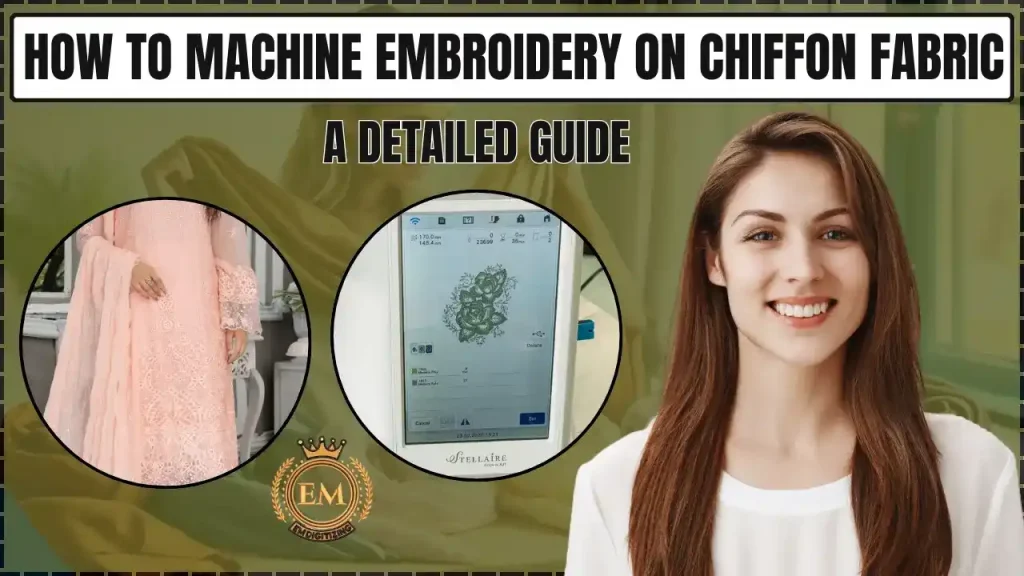
Come ricamare a macchina su tessuto chiffon: Una guida dettagliata
Materiali necessari per il ricamo su chiffon
Prima di iniziare, it’;È essenziale raccogliere i materiali giusti per garantire un ricamo fluido. Here’;s a quick list of the tools you’;avrò bisogno:
- Macchina da ricamo
- Tessuto chiffon
- Stabilizzatore (strappare o lavare via)
- Telaio da ricamo
- Aghi da ricamo (taglia 75/11 affilato)
- Filo da ricamo sottile (40-poliestere o rayon pesante)
- Spray adesivo temporaneo o stabilizzatore adesivo
- Forbici
Descrizione dettagliata di ciascun materiale:
- Macchina da ricamo: Scegli un macchina da ricamo che consente regolazioni di tensione e velocità. Lo chiffon è delicato, and you’;Dovrai ottimizzare le impostazioni della macchina per gestire il tessuto senza danneggiarlo.
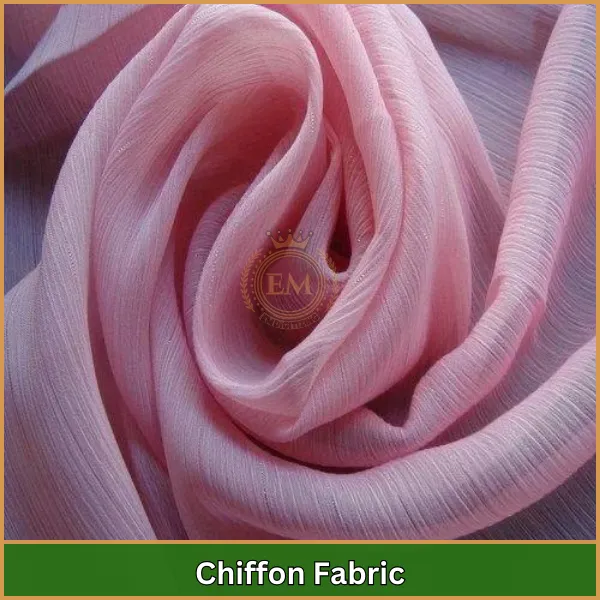
- Tessuto chiffon: Come un tessuto leggero e trasparente, lo chiffon è comunemente realizzato in seta, nylon, o poliestere. La sua trama fine richiede un'attenta manipolazione durante il ricamo per evitare intoppi, increspature, o lacrime.
- Stabilizzatore: Lo stabilizzatore è fondamentale quando si fa ricamo a macchina sullo chiffon. Uno stabilizzatore a strappo funziona bene per i progetti leggeri, mentre uno stabilizzatore lavabile è perfetto per progetti più complessi che necessitano di supporto extra senza lasciare residui.
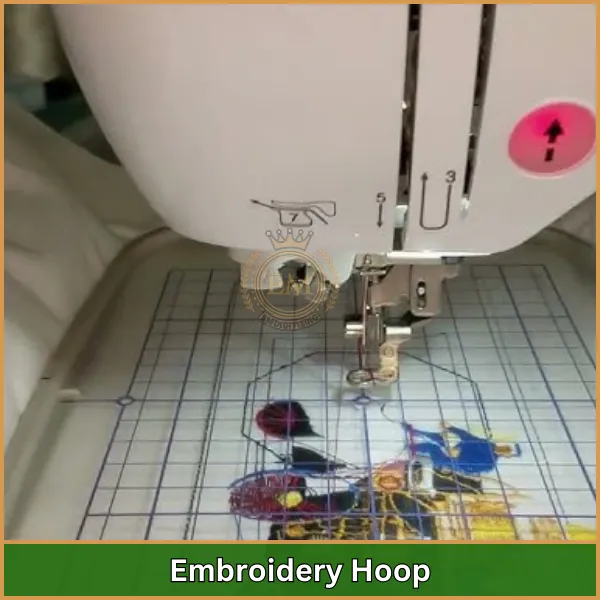
- Telaio da ricamo: Poiché lo chiffon tende a scivolare, è fondamentale utilizzare un telaio da ricamo che mantenga saldamente il tessuto. Assicurati di non allungare il tessuto durante l'inserimento nel telaio, in quanto ciò potrebbe distorcere il tuo design.

- Aghi da ricamo: Dimensione 75/11 gli aghi affilati sono ideali per lo chiffon. Penetrano dolcemente nel tessuto delicato senza causare danni o tirare le fibre.

- Filo da ricamo pregiato: Usa un filo leggero, come poliestere o rayon da 40 pesi. Questi fili aggiungono eleganza al design pur mantenendo la morbidezza dello chiffon.
- Spray adesivo temporaneo: Per mantenere stabile lo chiffon durante il processo di ricamo, è possibile utilizzare uno spray adesivo temporaneo per attaccare lo stabilizzatore al tessuto senza spostarsi.

- Forbici: Piccolo, affilato forbici da ricamo sono essenziali per tagliare i fili e tagliare gli stabilizzatori vicino al disegno una volta completato il ricamo.
Processo passo passo per il ricamo a macchina su tessuto chiffon
Per ottenere i migliori risultati, segui attentamente questi passaggi quando lavori su ricami a macchina su tessuti come lo chiffon.
Fare un passo 1: Preparare lo chiffon per il ricamo
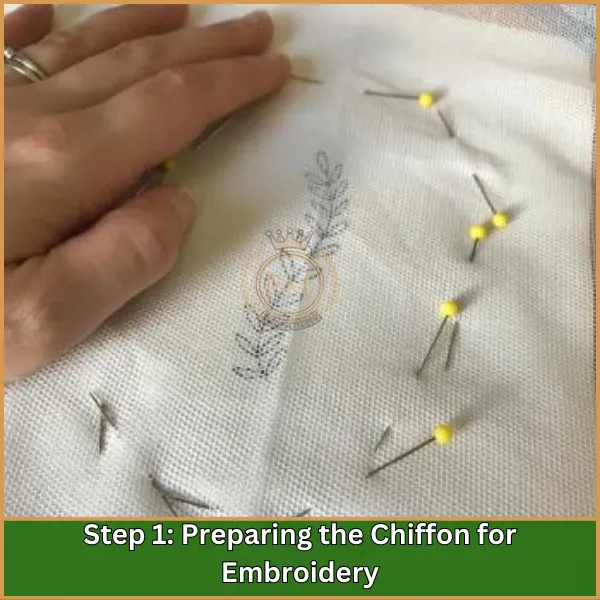
La preparazione è un primo passo cruciale quando si esegue il ricamo a macchina sullo chiffon. Per garantire un risultato positivo, seguire questi passaggi secondari:
- Scegliere lo stabilizzatore giusto: Utilizzare uno stabilizzatore adatto al design. Gli stabilizzatori a strappo sono eccellenti per i progetti leggeri, mentre gli stabilizzatori lavabili funzionano meglio per motivi più complessi.
- Utilizzo di adesivo temporaneo: Applicare uno strato sottile di spray adesivo temporaneo sullo stabilizzatore prima di attaccare lo chiffon. Ciò impedirà lo spostamento durante il processo di ricamo e ridurrà le arricciature.
- Intelaiare il tessuto: Dopo aver collegato lo stabilizzatore, posizionare delicatamente il tessuto nel telaio da ricamo. Assicurati che sia piatto e teso, ma evita di allungare lo chiffon, poiché potrebbe distorcere il disegno di ricamo finale.
Fare un passo 2: Scegliere il disegno da ricamo giusto
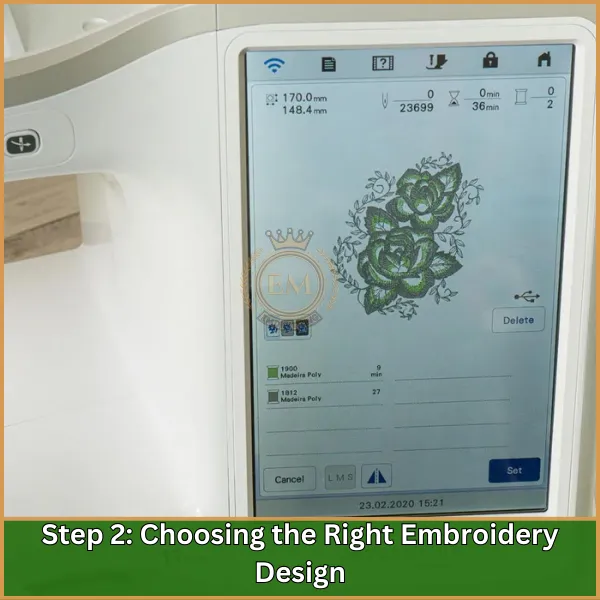
Quando si seleziona un disegno per il ricamo a macchina su chiffon, optare per design leggeri e ariosi. I motivi pesanti o densi possono causare arricciature o addirittura strappare il tessuto. Scegli disegni che si adattino alla natura delicata del tessuto, come motivi floreali, forme geometriche, o disegni simili a pizzi.
RICORDARE: In EMDigitalizzazione, offriamo servizi professionali di digitalizzazione del ricamo su misura per tessuti delicati come lo chiffon. Whether you’;stai cercando design personalizzati o hai bisogno di aiuto per convertire le opere d'arte in file di ricamo, il nostro team qualificato garantisce risultati di alta qualità a prezzi convenienti. Lasciaci gestire i dettagli tecnici così potrai concentrarti sui tuoi progetti di ricamo creativo!
Regolazione delle impostazioni della macchina: Abbassa la velocità e la tensione della macchina da ricamo per evitare che lo chiffon si tiri o si strappi durante la cucitura. Queste impostazioni sono essenziali per garantire che il tessuto rimanga intatto e il disegno sia liscio.
Fare un passo 3: Ricamo su tessuto chiffon
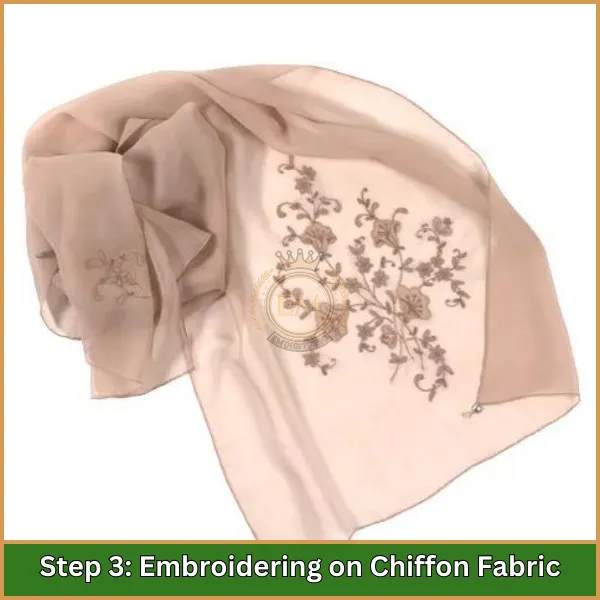
Ora che il tessuto è preparato e intelaiato, it’;È ora di iniziare il processo di ricamo vero e proprio.
- Esecuzione di un punto di prova: Prima di ricamare sul tuo progetto principale, è una buona idea eseguire un test su un pezzo di chiffon di scarto utilizzando lo stesso stabilizzatore e lo stesso design. Ciò consente di controllare la tensione, colore del filo, e garantire che il progetto venga fuori come previsto.
- Inizio del ricamo: Inizia a cucire lentamente. Poiché lo chiffon è delicato, una velocità di cucitura più lenta aiuta a mantenere il tessuto stabile e riduce il rischio di arricciature o disallineamento.
- Monitoraggio durante il ricamo: Mentre ricami, tieni d'occhio il processo per assicurarti che il tessuto non si sposti o non si arricci. Se noti problemi, mettere in pausa la macchina e apportare le modifiche. Ciò è particolarmente importante quando si eseguono ricami a macchina su chiffon, poiché il tessuto può scivolare o spiegazzarsi facilmente.
Fare un passo 4: Finiture
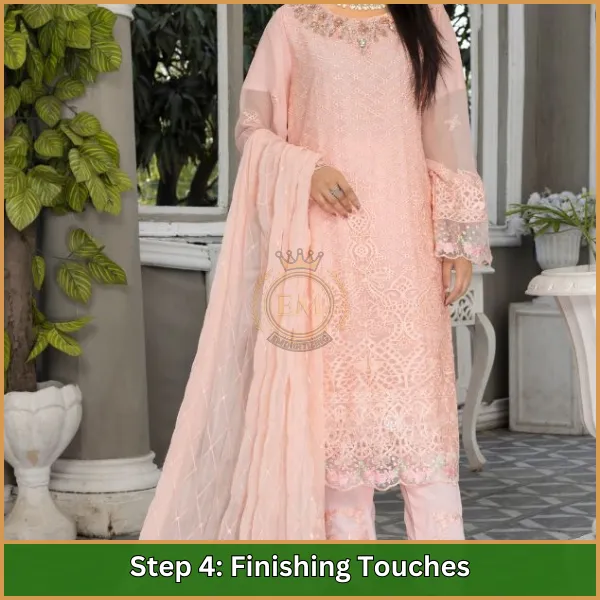
Una volta che il tuo design è completo, rimuovere con attenzione il tessuto dal telaio. Maneggiare delicatamente lo chiffon per evitare di allungare o danneggiare il tessuto.
- Taglio di fili sciolti: Usa delle forbici affilate per tagliare eventuali fili sciolti dalla parte anteriore e posteriore del tessuto. Ciò conferirà al ricamo un aspetto ordinato, aspetto professionale.
- Rimozione dello stabilizzatore: Se hai utilizzato uno stabilizzatore a strappo, strappalo con attenzione dal retro del tessuto senza tirare troppo forte il delicato chiffon. Per stabilizzanti lavabili, sciacquare delicatamente la zona con acqua per sciogliere lo stabilizzatore.
Risoluzione dei problemi comuni di ricamo sul tessuto in chiffon
Anche con la migliore preparazione, a volte possono sorgere problemi quando si esegue il ricamo a macchina sullo chiffon. Ecco alcuni problemi comuni e come risolverli:
- Arricciature del tessuto: Le arricciature si verificano quando il tessuto si sposta o si allunga durante il ricamo. Per evitare questo, assicurati che lo stabilizzatore aderisca correttamente allo chiffon e che il tessuto sia inserito saldamente nel telaio senza essere allungato.
- Rottura del filo: Se il filo continua a rompersi, potrebbe essere dovuto all'elevata tensione o al tipo di filo sbagliato. Prova a utilizzare un filo più leggero e a ridurre la tensione sulla macchina.
- Punti saltati: I punti saltati spesso si verificano quando l'ago è troppo grosso o smussato per il tessuto. Assicurati di utilizzare un ago affilato (taglia 75/11) e sostituiscilo regolarmente durante il tuo progetti di ricamo.
Prendersi cura dello chiffon ricamato
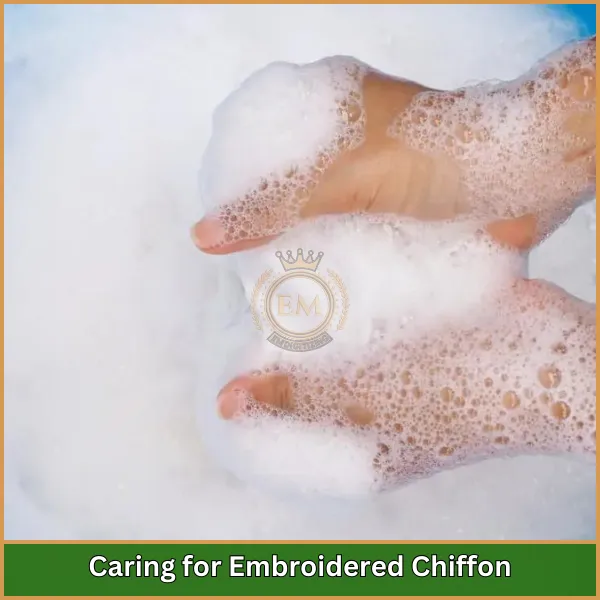
Once you’;Ho completato il ricamo a macchina su chiffon, it’;È importante prendersi cura del pezzo ricamato per garantirne la longevità.
- Lavaggio: Lavare a mano lo chiffon in acqua fredda con un detersivo delicato. Evitare di strofinare o strizzare il tessuto, poiché ciò potrebbe danneggiare il ricamo. Premere delicatamente per eliminare l'acqua in eccesso e stendere il tessuto ad asciugare.
- Stirare: Se lo chiffon ha bisogno di essere stirato, farlo con grande cura. Imposta il ferro a una temperatura bassa, e posizionare sempre un panno pressante sul ricamo per proteggere i punti. Evitare di stirare direttamente sulla zona ricamata, poiché ciò potrebbe appiattire il disegno o danneggiare la filettatura.
Conclusione
Insomma, if you’;stai pensando di ricamare su un tessuto di chiffon, EMdigitizing può contribuire a rendere il processo molto più fluido. Offriamo specializzato servizi di digitalizzazione del ricamo su misura per tessuti delicati come lo chiffon, assicurando che i tuoi disegni risultino impeccabili ed eleganti.
Il nostro team di esperti può convertire qualsiasi opera d'arte in file pronti per il ricamo, perfettamente adatto per lo chiffon, così potrai concentrarti sugli aspetti creativi del tuo progetto. E come bonus, i clienti per la prima volta ricevono a 50% sconto sul loro primo ordine.
Contatta EMdigitizing oggi stesso per dare vita ai tuoi ricami in chiffon!
Domande frequenti
sì, puoi ricamare a macchina sullo chiffon, ma richiede un'attenta manipolazione e stabilizzazione per evitare arricciature o danni.
È possibile il ricamo a macchina su tessuto velato, utilizzando uno stabilizzatore adatto per sostenere il tessuto durante il processo di ricamo.
Tessuti eccessivamente elastici, Troppo sottile, o a trama troppo larga, come alcune maglie e lenzuola leggere, può essere impegnativo e potrebbe non produrre i migliori risultati di ricamo.
I migliori tessuti per ricamo a macchina sono stabili, tessuti di peso medio come il cotone, biancheria, seta, e miscele di poliestere che forniscono una superficie liscia e un'elasticità minima.
